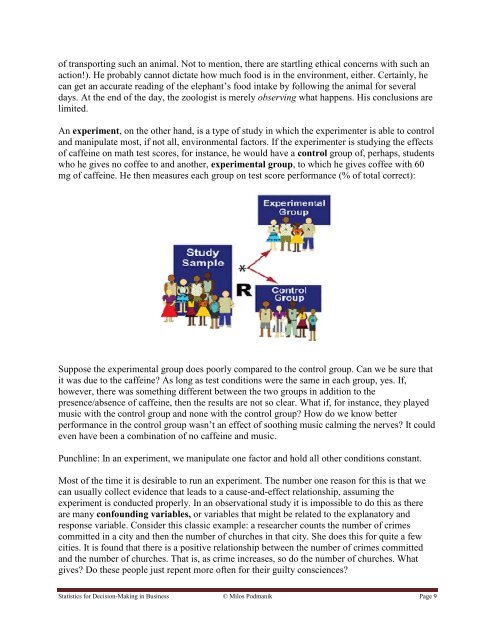Statistics for Decision- Making in Business - Maricopa Community ...
Statistics for Decision- Making in Business - Maricopa Community ...
Statistics for Decision- Making in Business - Maricopa Community ...
You also want an ePaper? Increase the reach of your titles
YUMPU automatically turns print PDFs into web optimized ePapers that Google loves.
of transport<strong>in</strong>g such an animal. Not to mention, there are startl<strong>in</strong>g ethical concerns with such an<br />
action!). He probably cannot dictate how much food is <strong>in</strong> the environment, either. Certa<strong>in</strong>ly, he<br />
can get an accurate read<strong>in</strong>g of the elephant‟s food <strong>in</strong>take by follow<strong>in</strong>g the animal <strong>for</strong> several<br />
days. At the end of the day, the zoologist is merely observ<strong>in</strong>g what happens. His conclusions are<br />
limited.<br />
An experiment, on the other hand, is a type of study <strong>in</strong> which the experimenter is able to control<br />
and manipulate most, if not all, environmental factors. If the experimenter is study<strong>in</strong>g the effects<br />
of caffe<strong>in</strong>e on math test scores, <strong>for</strong> <strong>in</strong>stance, he would have a control group of, perhaps, students<br />
who he gives no coffee to and another, experimental group, to which he gives coffee with 60<br />
mg of caffe<strong>in</strong>e. He then measures each group on test score per<strong>for</strong>mance (% of total correct):<br />
Suppose the experimental group does poorly compared to the control group. Can we be sure that<br />
it was due to the caffe<strong>in</strong>e As long as test conditions were the same <strong>in</strong> each group, yes. If,<br />
however, there was someth<strong>in</strong>g different between the two groups <strong>in</strong> addition to the<br />
presence/absence of caffe<strong>in</strong>e, then the results are not so clear. What if, <strong>for</strong> <strong>in</strong>stance, they played<br />
music with the control group and none with the control group How do we know better<br />
per<strong>for</strong>mance <strong>in</strong> the control group wasn‟t an effect of sooth<strong>in</strong>g music calm<strong>in</strong>g the nerves It could<br />
even have been a comb<strong>in</strong>ation of no caffe<strong>in</strong>e and music.<br />
Punchl<strong>in</strong>e: In an experiment, we manipulate one factor and hold all other conditions constant.<br />
Most of the time it is desirable to run an experiment. The number one reason <strong>for</strong> this is that we<br />
can usually collect evidence that leads to a cause-and-effect relationship, assum<strong>in</strong>g the<br />
experiment is conducted properly. In an observational study it is impossible to do this as there<br />
are many confound<strong>in</strong>g variables, or variables that might be related to the explanatory and<br />
response variable. Consider this classic example: a researcher counts the number of crimes<br />
committed <strong>in</strong> a city and then the number of churches <strong>in</strong> that city. She does this <strong>for</strong> quite a few<br />
cities. It is found that there is a positive relationship between the number of crimes committed<br />
and the number of churches. That is, as crime <strong>in</strong>creases, so do the number of churches. What<br />
gives Do these people just repent more often <strong>for</strong> their guilty consciences<br />
<strong>Statistics</strong> <strong>for</strong> <strong>Decision</strong>-<strong>Mak<strong>in</strong>g</strong> <strong>in</strong> Bus<strong>in</strong>ess © Milos Podmanik Page 9
















